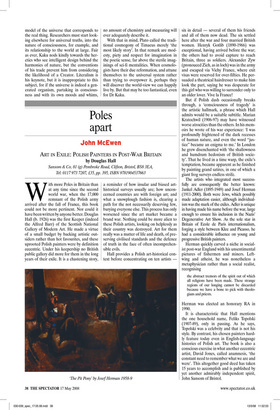Poles apart
John McEwen
ART IN EXILE: POLISH PAINTERS IN POST-WAR BRITAIN by Douglas Hall Sansom & Co, 81 (g) Pembroke Road, Clifton, Bristol, BS8 3EA, Tel: 0117 973 7207, £35, pp. 395, ISBN 9781904537663 With more Poles in Britain than at any time since the second world war, when the 17,000 remnant of the Polish army arrived after the fall of France, this book could not be more pertinent. Nor could it have been written by anyone better. Douglas Hall (b. 1926) was the first Keeper (indeed the Alfred Barr) of the Scottish National Gallery of Modern Art. He made a virtue of a small budget by backing artistic outsiders rather than hot favourites, and these uprooted Polish painters were by definition eccentric. Under his keepership no British public gallery did more for them in the long years of their exile. It is a chastening story, a reminder of how insular and biased arthistorical surveys usually are; how unconcerned countries are with foreign art; and what a snowplough fashion is, clearing a path for the not necessarily deserving few, burying everyone else. This process has only worsened since the art market became a brand war. Nothing could be more alien to these Polish artists, looking on helplessly as their country was destroyed. Art for them really was a matter of life and death, of preserving civilised standards and the defence of truth in the face of often incomprehensible evils.
Hall provides a Polish art-historical context before concentrating on ten artists — six in detail — several of them his friends and all of them now dead. The six settled here after the war and four married British women. Henryk Gotlib (1890-1966) was exceptional, having arrived before the war; the others had to avoid capture to reach Britain, three as soldiers. Alexander Zyw (pronouced Zich, as in loch) was in the army and escaped via Vichy France, where exit visas were reserved for over-fifties. He persuaded a theatrical hairdresser to make him look the part, saying he was desperate for this girl who was willing to surrender only to an older lover. Vive la France!
But if Polish dash occasionally breaks through, a ‘consciousness of tragedy’ is the artistic hallmark, a phrase which Hall admits would be a suitable subtitle. Marian Kratochwil (1906-97) may have witnessed worse atrocities than the others. In his memoirs he wrote of his war experience: ‘I was profoundly frightened of the dark recesses of human nature, and even the word “justice” became an enigma to me.’ In London he grew disenchanted with ‘the shallowness and humdrum hedonism of British society’. That he lived in a time warp, the exile’s temptation, became apparent as he finished by painting grand satires, in one of which a giant frog surveys endless strife.
The artists who integrated most successfully are consequently the better known: Jankel Adler (1895-1949) and Josef Herman (1911-2000). Both were Jews, which possibly made adaptation easier, although individualism was the mark of the exiles. Adler is unique in having made his name before the war, large enough to ensure his inclusion in the Nazis’ Degenerative Art Show. As the sole star in Britain of Ecole de Paris internationalism, forging a style between Klee and Picasso, he had a considerable influence on young and progressive British painters.
Herman quickly carved a niche in socialist post-war England with his unsentimental pictures of fishermen and miners. Leftwing and atheist, he was nonetheless a metaphysician rather than a social realist, recognising
the abstract tremors of the spirit out of which all religions have been made. These strange regions of our longing cannot be discarded because we have a bone to pick with theologians and priests.
Herman was elected an honorary RA in 1990.
It is characteristic that Hall mentions the one household name, Feliks Topolski (1907-89), only in passing. As he says, Topolski was a celebrity and that is not his style. By contrast, his chosen painters hardly feature today even in English-language histories of Polish art. The book is also a conscious exercise in what another eccentric artist, David Jones, called anamnesis, ‘the constant need to remember what we are and were’. This altogether good deed has taken 15 years to accomplish and is published by yet another admirably independent spirit, John Sansom of Bristol.










































































 Previous page
Previous page